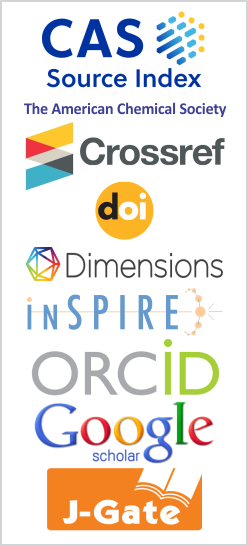Ambient Conditioned, Solution Processed CuO Nanoflakes over Carbon Fabric for Supercapacitor Application: Performance Enhancement via Nanoparticle Attachment
DOI:
https://doi.org/10.26713/jamcnp.v2i2.274Keywords:
Chemical synthesis, Heterostructure, SupercapacitorAbstract
All Solid-state supercapacitors based on pure CuO nanoflakes and CuO@Au heterostructure over carbon cloth were fabricated where directly functioned nanostructure over carbon fiber acts as electrode and detour the necessity of any binder or ancillary materials. High coverage of CuO nanoflakes over entire cylindrical surface of each fiber provide decent electrochemical which nwas further uplifted after Au nanoparticle decoration. Registered electrochemical performance from CuO nanoflakes was found to be 11 F/g at current density 0.5A/g which significantly improved to 26 F/g at the same current density after nanoparticle attachment. Increase in surface area as well as increment of overall conductivity of the hybrid system due to Au nanoparticle attachment may accredit for such performance enrichment. All Solid-state supercapacitors based on pure CuO nanoflakes and CuO@Au heterostructure over carbon cloth were fabricated where directly functioned nanostructure over carbon fib eracts as electrode and detour the necessity of any binder or ancillary materials. High coverage of CuO nanoflakes over entire cylindrical surface of each fiber provide decent electrochemical which was further uplifted after Au nanoparticle decoration. Registered electrochemical performance from CuO nanoflakes was found to be 11 F/g at current density0.5A/g which significantly improved to 26 F/g at the same current density after nanoparticle attachment. Increase in surface area as well as increment of overall conductivity of the hybrid system due to Au nanoparticle attachment may accredit for such performance enrichment.Downloads
References
P. Simon and Y. Gogotsi, Nat. Mater., 7 (2008), 845–854.
D. Pech, M. Brunet, H. Durou, P. Huang, V. Mochalin, Y. Gogotsi, P. L. Taberna and P. Simon, Nat. Nanotechnol., 5 (2010), 651–654.
Y.-H. Wang, C.-C. Wang, W.-Y. Cheng and S.-Y. Lu, Carbon, 69 (2014) 287–293.
K. Krishnamoorthy and S.-J. Kim, Mater Res Bull, 48 (2013), 3136–3139.
L. Hu, W. Chen, X. Xie, N. Liu, Y. Yang, H. Wu, Y. Yao, M. Pasta, H.N. Alshareef and Y. Cui, ACS Nano, 5 (2011), 8904–8913.
G. Yu, L. Hu, M. Vosgueritchian, H. Wang, X. Xie, J. R. McDonough, X. Cui, Y. Cui, and Z. Bao, Nano Lett., 11 (2011), 2905– 2911.
X. Lu, G. Wang, T. Zhai, M. Yu, S. Xie, Y. Ling, C. Liang, Y. Tong and Y. Li, Nano Lett., 12 (2012), 5376–5381.
X. Lu, T. Zhai, X. Zhang, Y. Shen, L. Yuan, B. Hu, L. Gong, J. Chen, Y. Gao, J. Zhou, Adv. Mater., 24 (2012), 938–944. 8
Q. Cheng, J. Tang, J. Ma, H. Zhang, N. Shinya and L.-C. Qin, J. Phys. Chem. C, 115 (2011), 23584–23590.
U. N. Maiti, S. Maiti and K. K. Chattopadhyay, Cryst Eng Comm, 14 (2012), 640-647.
Y. L. Wang, J. J. Xu, H. Wu, M. Xu, Z. Peng and G. F. Zheng, J. Mater. Chem., 22 (2012), 21923–21927.
Downloads
Published
How to Cite
Issue
Section
License
Authors who publish with this journal agree to the following terms:- Authors retain copyright and grant the journal right of first publication with the work simultaneously licensed under a CCAL that allows others to share the work with an acknowledgement of the work's authorship and initial publication in this journal.
- Authors are able to enter into separate, additional contractual arrangements for the non-exclusive distribution of the journal's published version of the work (e.g., post it to an institutional repository or publish it in a book), with an acknowledgement of its initial publication in this journal.
- Authors are permitted and encouraged to post their work online (e.g., in institutional repositories or on their website) prior to and during the submission process, as it can lead to productive exchanges, as well as earlier and greater citation of published work.




